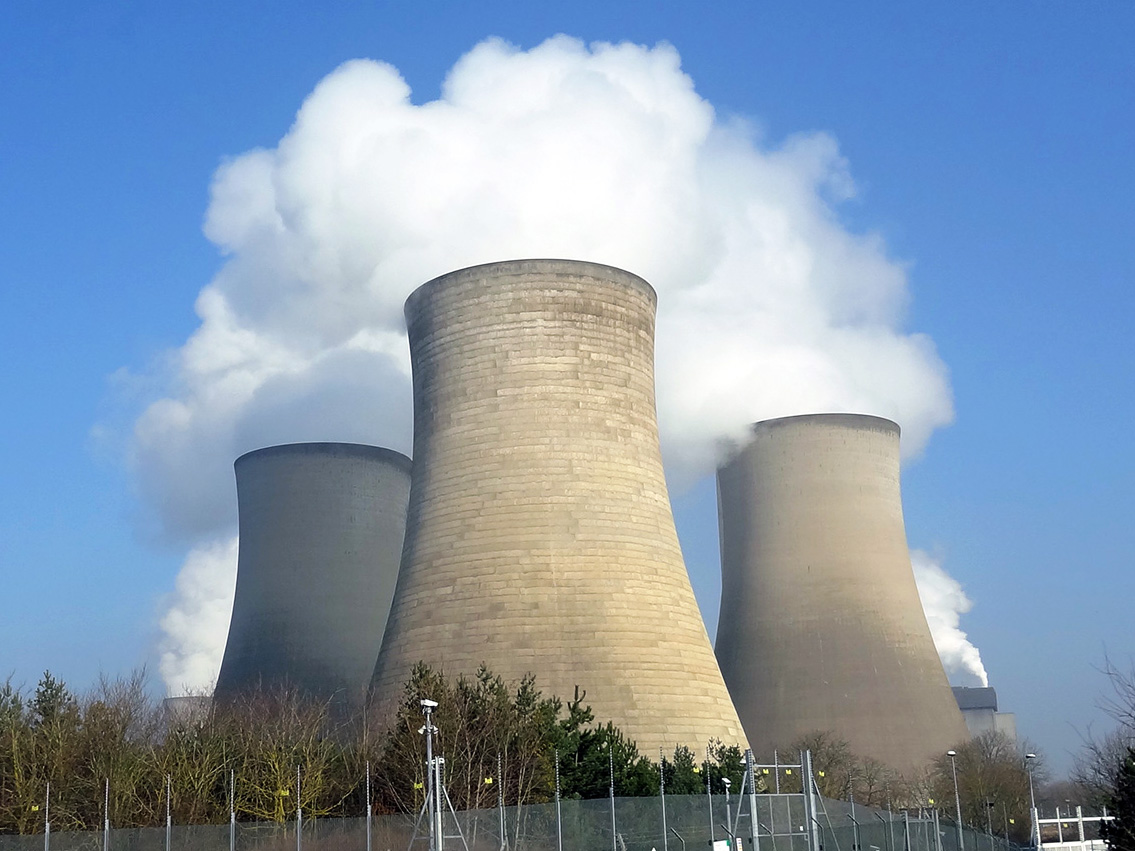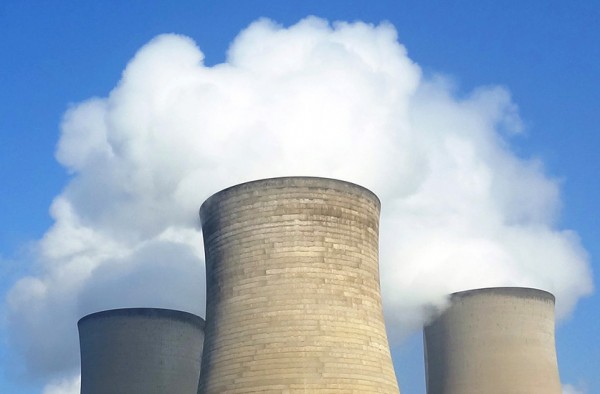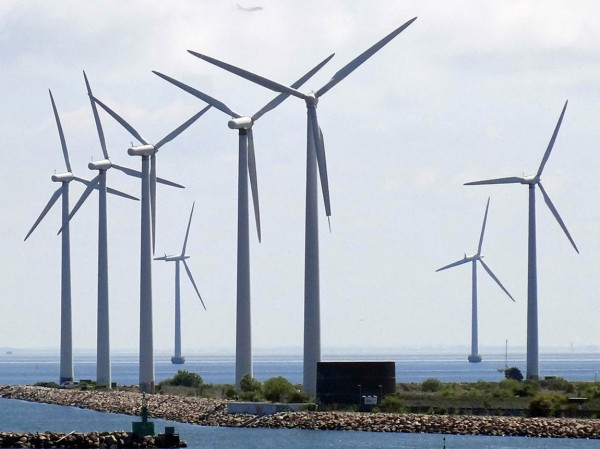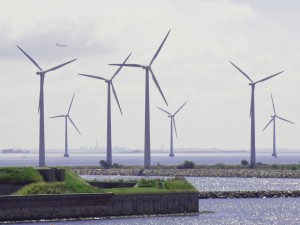 In December 2015, countries from around the world met in Paris at the United Nations Intergovernmental Panel on Climate Change (IPCC). The key element of the resulting Paris Agreement was to keep ‘global temperature rise this century well below 2 degrees Celsius above pre-industrial levels and to pursue efforts to limit the temperature increase even further to 1.5 degrees Celsius.’ At the same time it was agreed that the IPCC would conduct an analysis of what would need to be done to limit global warming to 1.5°C. The IPPC has just published its report.
In December 2015, countries from around the world met in Paris at the United Nations Intergovernmental Panel on Climate Change (IPCC). The key element of the resulting Paris Agreement was to keep ‘global temperature rise this century well below 2 degrees Celsius above pre-industrial levels and to pursue efforts to limit the temperature increase even further to 1.5 degrees Celsius.’ At the same time it was agreed that the IPCC would conduct an analysis of what would need to be done to limit global warming to 1.5°C. The IPPC has just published its report.
The report, based on more than 6000 scientific studies, has been compiled by more than 80 of the world’s top climate scientists. It states that, with no additional action to mitigate climate change beyond that committed in the Paris Agreement, global temperatures are likely to rise to the 1.5°C point somewhere between 2030 and 2040 and then continue rising above that, reaching 3°C by the end of the century.
 According to the report, the effects we are already seeing will accelerate. Sea levels will rise as land ice caps and glaciers melt, threatening low lying coastal areas; droughts and floods will become more severe; hurricanes and cyclones will become stronger; the habits of many animals will become degraded and species will become extinct; more coral reefs will die and fish species disappear; more land will become uninhabitable; more displacement and migration will take place, leading to political tensions and worse.
According to the report, the effects we are already seeing will accelerate. Sea levels will rise as land ice caps and glaciers melt, threatening low lying coastal areas; droughts and floods will become more severe; hurricanes and cyclones will become stronger; the habits of many animals will become degraded and species will become extinct; more coral reefs will die and fish species disappear; more land will become uninhabitable; more displacement and migration will take place, leading to political tensions and worse.
Two tragedies

The problem of greenhouse gas emissions and global warming is a classic case of the tragedy of the commons. This is where people overuse common resources, such as open grazing land, fishing grounds, or, in this case, the atmosphere as a dump for emissions. They do so because there is little, if any, direct short-term cost to themselves. Instead, the bulk of the cost is borne by others – especially in the future.
There is another related tragedy, which has been dubbed the ‘tragedy of incumbents’. This is a political problem where people in power  want to retain that power and do so by appealing to short-term selfish interests. The Trump administration lauds the use of energy as helping to drive the US economy and make people better off. To paraphrase Donald Trump ‘Climate change may be happening, but, hey, let’s not beat ourselves up about it and wear hair shirts. What we do will have little or no effect compared with what’s happening in China and India. The USA is much better off with a strong automobile, oil and power sector.’
want to retain that power and do so by appealing to short-term selfish interests. The Trump administration lauds the use of energy as helping to drive the US economy and make people better off. To paraphrase Donald Trump ‘Climate change may be happening, but, hey, let’s not beat ourselves up about it and wear hair shirts. What we do will have little or no effect compared with what’s happening in China and India. The USA is much better off with a strong automobile, oil and power sector.’
What’s to be done?
According to the IPCC report, if warming is not to exceed 1.5℃, greenhouse gas emissions must be reduced by 45% by 2030 and by 100% by around 2050. But is this achievable?
 The commitments made in the Paris Agreement will not be nearly enough to achieve these reductions. There needs to be a massive movement away from fossil fuels, with between 70% and 85% of global electricity production being from renewables by 2050. There needs to be huge investment in green technology for power generation, transport and industrial production.
The commitments made in the Paris Agreement will not be nearly enough to achieve these reductions. There needs to be a massive movement away from fossil fuels, with between 70% and 85% of global electricity production being from renewables by 2050. There needs to be huge investment in green technology for power generation, transport and industrial production.
In addition, the report recommends investing in atmospheric carbon extraction technologies. Other policies to reduce carbon include massive reforestation.
Both these types of policies involve governments taking action, whether through increased carbon taxes on either producers or consumer or both, or through increased subsidies for renewables and other alternatives, or through the use of cap and trade with emissions allocations (either given by government or sold at auction) and carbon trading, or through the use of regulation to prohibit or limit behaviour that leads to emissions. The issue, of course, is whether governments have the will to do anything. Some governments do, but with the election of populist leaders, such as President Trump in the USA, and probably Jair Bolsonaro in Brazil, and with sceptical governments in other countries, such as Australia, this puts even more onus on other governments.
Another avenue is a change in people’s attitudes, which may be influenced by education, governments, pressure groups, news media, etc. For example, if people could be persuaded to eat less meat, drive less (for example, by taking public transport, walking, cycling, car sharing or living nearer to their work), go on fewer holidays, heat their houses less, move to smaller homes, install better insulation, etc., these would all reduce greenhouse gas emissions.
 Finally, there is the hope that the market may provide part of the solution. The cost of generating electricity from renewables is coming down and is becoming increasingly competitive with electricity generated from fossil fuels. Electric cars are coming down in price as battery technology develops; also, battery capacity is increasing and recharging is becoming quicker, helping encourage the switch from petrol and diesel cars to electric and hybrid cars. At the same time, various industrial processes are becoming more fuel efficient. But these developments, although helpful, will not be enough to achieve the 1.5°C target on their own.
Finally, there is the hope that the market may provide part of the solution. The cost of generating electricity from renewables is coming down and is becoming increasingly competitive with electricity generated from fossil fuels. Electric cars are coming down in price as battery technology develops; also, battery capacity is increasing and recharging is becoming quicker, helping encourage the switch from petrol and diesel cars to electric and hybrid cars. At the same time, various industrial processes are becoming more fuel efficient. But these developments, although helpful, will not be enough to achieve the 1.5°C target on their own.
Videos and audio
Articles
- We must reduce greenhouse gas emissions to net zero or face more floods
The Guardian, Nicholas Stern (8/10/18)
- Rapid, unprecedented change needed to halt global warming – U.N.
Reuters, Nina Chestney and Jane Chung (8/10/18)
- Final call to save the world from ‘climate catastrophe’
BBC News, Matt McGrath (8/10/18)
- New UN report outlines ‘urgent, transformational’ change needed to hold global warming to 1.5°C
The Conversation, Mark Howden and Rebecca Colvin (8/10/18)
- Earth’s temperature to rise 1.5C as early as 2030 amid dire warnings from UN climate panel
The Telegraph (8/10/18)
- UN Climate Change Report: Everything You Need To Know
Huffington Post, Isabel Togoh (8/10/18)
- Thirty years of the IPCC
Physics World (8/10/18)
- 13 things you should know about 1.5
Unearthed, Zach Boren (8/10/18)
- Climate change impacts worse than expected, global report warns
National Geographic, Stephen Leahy (7/10/18)
- World to miss Paris climate targets by wide margin, says UN panel
Financial Times, Leslie Hook (8/10/18)
- We have 12 years to limit climate change catastrophe, warns UN
The Guardian, Jonathan Watts (8/10/18)
- Limiting warming to 1.5C is possible – if there is political will
The Guardian, Christiana Figueres (8/10/18)
- The Trump administration has entered Stage 5 climate denial
The Guardian, Dana Nuccitelli (8/10/18)
- ‘Unprecedented changes’ needed to stop global warming as UN report reveals islands starting to vanish and coral reefs dying
Independent, Josh Gabbatiss (8/10/18)
Report
Questions
- Explain the extent to which the problem of global warming is an example of the tragedy of the commons. What other examples are there of the tragedy?
- Explain the meaning of the tragedy of the incumbents and its impact on climate change? Does the length of the electoral cycle exacerbate the problem?
- With the costs of low or zero carbon technology for energy and transport coming down, is there as case for doing nothing in response to the problem of global warming?
- Examine the case for and against using taxes and subsidies to tackle global warming.
- Examine the case for and against using regulation to tackle global warming.
- Examine the case for and against using cap-and-trade systems to tackle global warming.
- Is there a prisoners’ dilemma problem in getting governments to adopt policies to tackle climate change?
- What would be the motivation for individuals to ‘do their bit’ to tackle climate change? Other than altering prices or using regulation, how might the government or other agencies set about persuading people to ‘be more green’?
- If you were doing a cost–benefit analysis of some project that will have beneficial environmental impacts in the future, how would you set about adjusting the values of these benefits for the fact that they occur in the future and not now?
 Is slower economic growth a cost of cutting greenhouse gas emissions? Apparently not – at least according to two studies: one by DIW Econ, a German institute for economic research, and the other, earlier this year, by the International Energy Association (see reports below).
Is slower economic growth a cost of cutting greenhouse gas emissions? Apparently not – at least according to two studies: one by DIW Econ, a German institute for economic research, and the other, earlier this year, by the International Energy Association (see reports below).
The IEA study found that, despite global GDP having grown by 6.4% in 2014, global emissions remained flat. The DIW Econ study found that from 2004 to 2014, OECD countries as a whole grew by 16% while cutting fossil fuel consumption by 6% and greenhouse gas emissions by 6.4%.
But what does this mean? If growth accelerated, what would happen to greenhouse gas emissions? Would they begin to rise again? Probably.
The point is that various developments, largely independent of economic growth have been reducing the greenhouse gas emissions/GDP ratio. These developments include: technological advances in energy generation; the switch to alternative fuels in many countries, thanks, in large part to lower renewable energy costs; increased energy efficiency by consumers; and a continuing move from energy-intensive manufacturing to less energy-intensive services.
 So if governments forced more radical cuts in greenhouse gases, would this reduce the rate of economic growth or have no effect? For a given level of technological advancement, the initial effect would probably be a reduction in economic growth. But to the extent that this encouraged further investment in renewables and energy saving, it might even stimulate economic growth over the longer term, especially if it helped to bring lower energy prices.
So if governments forced more radical cuts in greenhouse gases, would this reduce the rate of economic growth or have no effect? For a given level of technological advancement, the initial effect would probably be a reduction in economic growth. But to the extent that this encouraged further investment in renewables and energy saving, it might even stimulate economic growth over the longer term, especially if it helped to bring lower energy prices.
A big problem in decoupling economic growth from fossil fuel usage is that developing countries, which are taking a growing share of world manufacturing, are more heavily dependent on coal than most developed countries. But even here there seems to be some hope. China, the biggest manufacturer in the developing world, is rapidly increasing its use of renewables. As the IEA press release states:
In China, 2014 saw greater generation of electricity from renewable sources, such as hydropower, solar and wind, and less burning of coal.
If the world is to tackle global warming by making significant cuts in greenhouse gases, there must be a way for developing countries to continue growing while making less use of fossil fuels.
Article
Cutting greenhouse gas emissions won’t slow global economic growth — report The Guardian, Bruce Watson (26/9/15)
Reports
Turning point: Decoupling Greenhouse Gas Emissions from Economic Growth DIW Econ, Lars Handrich, Claudia Kemfert, Anselm Mattes, Ferdinand Pavel, Thure Traber (September 2015)
World Energy Outlook Special Report 2015: Energy and Climate Change International Energy Agency (June 2015)
Questions
- What are the possible causal relationships between cutting greenhouse gas emissions and the rate of economic growth?
- What incentive mechanisms can governments or other agencies adopt to encourage reductions in greenhouse gas emissions without reducing economic growth?
- Can a cap and trade system, such as the European Emissions Trading Scheme help to achieve a given level of emissions reduction at minimum cost to economic growth? Explain.
- How might the developed world support developing countries in moving to a low carbon technology?
- What factors lie behind the falling costs of renewable energy? Are these the same factors that lie behind the falling cost of oil?
- What political problems might hinder the greater production of renewable energy?
- How might an economist set about determining a socially optimal amount of fossil fuel production? What conceptual and philosophical problems might there be in agreeing what is meant by a social optimum?
 The UK hosted the third Clean Energy Ministerial conference on 25/26 April 2012. More than 20 energy ministers from around the world attended. In his address, David Cameron, gave his backing to more wind farms being built in the UK, both onshore and offshore.
The UK hosted the third Clean Energy Ministerial conference on 25/26 April 2012. More than 20 energy ministers from around the world attended. In his address, David Cameron, gave his backing to more wind farms being built in the UK, both onshore and offshore.
Currently just under 10 per cent of the UK’s electricity is generated from renewable sources. But to meet agreed EU targets this must increse to at least one-third by 2020. Most of this will have to come from wind.
But whilst wind turbines create no CO2 emissions, electricity generated from wind is currently some 15% more expensive than from gas. To make wind power profitable, energy companies are required by law to generate a certain percentage of their electricity from renewables and the cost is passed on to the consumer. This adds some £20 per year to the average household energy bill.
Over the coming years, many new power plants will have to be built to replace the electricity generated from older plants that reach the end of their life. So what types of plant should be built? Unfortunately measuring the costs and benefits from power generation is not easy. For a start, energy needs are not easy to predict. But more importantly, electricity generation involves huge environmental and social externalities. And these are extremely difficult to measure.
What is more, the topic is highly charged politically. The social costs do not fall evenly on the population. People might favour wind turbines, but they do not want to see one outside their window – or from their golf course!
The following videos and articles will give you some insight into the difficulties that any decision makers face in making the ‘right’ decisions about electricity generation
Webcasts and podcasts
 Can Cameron still claim the ‘greenest government ever’? Channel 4 News, Tom Clarke (26/4/12)
Can Cameron still claim the ‘greenest government ever’? Channel 4 News, Tom Clarke (26/4/12)
 Energy Secretary: UK will meet green targets BBC News, Ed Davey (25/4/12)
Energy Secretary: UK will meet green targets BBC News, Ed Davey (25/4/12)
 Donald Trump attacks Scottish government’s green policy BBC News, James Cook (25/4/12)
Donald Trump attacks Scottish government’s green policy BBC News, James Cook (25/4/12)
 Trump: Wind farms ‘bad for Scotland’ BBC News (24/4/12)
Trump: Wind farms ‘bad for Scotland’ BBC News (24/4/12)
 Tycoon Trump fights Scotland over wind farms near golf resortReuters, Deborah Gembara (25/4/12)
Tycoon Trump fights Scotland over wind farms near golf resortReuters, Deborah Gembara (25/4/12)
 Wind power blows Siemens off course Euronews, Anne Glemarec (25/4/12)
Wind power blows Siemens off course Euronews, Anne Glemarec (25/4/12)
 Mexico inaugurates largest wind farm in Latin America BBC News, Carolina Robino (9/3/12)
Mexico inaugurates largest wind farm in Latin America BBC News, Carolina Robino (9/3/12)
 BP’s Flat Ridge 2 Wind Farm in Kansas YouTube, BPplc (10/4/12)
BP’s Flat Ridge 2 Wind Farm in Kansas YouTube, BPplc (10/4/12)
 Arnold Schwarzenegger: Green quest goes on BBC News (26/4/12)
Arnold Schwarzenegger: Green quest goes on BBC News (26/4/12)
 Denmark Pioneers Clean Energy Green TV (18/4/12)
Denmark Pioneers Clean Energy Green TV (18/4/12)
 EU wind industry defies recession Green TV (16/4/12)
EU wind industry defies recession Green TV (16/4/12)
 Wind Farm Issues – Compilation LiveLeak (15/4/12)
Wind Farm Issues – Compilation LiveLeak (15/4/12)
News articles
David Cameron commits to wind farms The Telegraph, Louise Gray (26/4/12)
David Cameron says wind energy must get cheaper The Telegraph, Louise Gray (27/4/12)
Could 2012 be year of the wind turbine? The Telegraph, Louise Gray (3/2/12)
Green energy vital, says David Cameron Independent, Emily Beament (26/4/12)
Cameron: renewables are ‘vital to our future’ businessGreen, Will Nichols and James Murray (26/4/12)
Green energy ‘must be affordable’ – Cameron BBC News (26/4/12)
Wind farms will kill tourism, says Donald Trump Independent (25/4/12)
Donald Trump accuses Salmond of ‘betrayal’ over wind farm plans The Telegraph, Simon Johnson (25/4/12)
Turbine scheme provokes wuthering gale of protest Independent, Mark Branagan (6/4/12)
Prince Charles endorses wind power in new film at Sundance Festival The Telegraph, Roya Nikkhah (29/4/12)
Study claims tourists ‘not put off’ by wind farms in Scotland BBC News (24/4/12)
Tide turns in favour of wave power instead of wind farms Scotsman, David Maddox (23/4/12)
Rush towards wind-generated electricity will not reduce fuel poverty Power Engineering (21/4/12)
Shell says no to North Sea wind power Guardian, Terry Macalister (26/4/12)
David Cameron, the Speech He Needs to Make Huffington Post, Juliet Davenport (25/4/12)
Campaigners want David Cameron to come clean over wind farm policy Western Daily Press (27/4/12)
Being Green Doesn’t Mean Higher Electricity Costs Says Green Energy UK DWPub (27/4/12)
Documents
Cost Benefit Methodology for Optimal Design of Offshore Transmission Systems Centre for Sustainable Electricity and Distributed Generation, Predrag Djapic and Goran Strbac (July 2008)
A Cost Benefit Analysis of Wind Power University College Dublin, Eleanor Denny (19/1/07)
Ecological and economic cost-benefit analysis of offshore wind energy Renewable Energy 34, Brian Snyder, Mark J. Kaiser (2009)
Questions
- Why is difficult to predict the future (financial) cost per kilowatt-hour of electricity generation by the various methods?
- Why is it difficult to estimate the demand for electricity in 10 years’ time?
- Identify the external benefits and costs of electricity generation from (a) onshore wind turbines; (b) offshore wind turbines.
- Is ‘willingness to pay’ a good method of establishing the value of external benefits and costs?
- What are the steps in a cost–benefit analysis?
- What types of problems are there in measuring external benefits and costs?
In the article below, Ashley Seager from the Guardian argues that the government is doing little to encourage the take-up and adoption of alternative forms of energy generation for households. Indeed he argues hat the situation has got worse and not better in recent months with changes in the system. Only 270 houses were helped with the fitting of photovoltaic systems last year. In Germany the equivalent figure was 130,000.
Reasons to see red over green energy Guardian (18/2/08)
Questions
| 1. |
Assess the external costs and external benefits resulting from installing a photovoltaic electricity generation system on a house. |
| 2. |
Using diagrams as appropriate, show how the installation of photovoltaic cells on houses will alter the socially optimal market equilibrium. |
| 3. |
Evaluate two policies that the government could use to encourage the more widespread adoption of alternative methods of generating power. |
 In December 2015, countries from around the world met in Paris at the United Nations Intergovernmental Panel on Climate Change (IPCC). The key element of the resulting Paris Agreement was to keep ‘global temperature rise this century well below 2 degrees Celsius above pre-industrial levels and to pursue efforts to limit the temperature increase even further to 1.5 degrees Celsius.’ At the same time it was agreed that the IPCC would conduct an analysis of what would need to be done to limit global warming to 1.5°C. The IPPC has just published its report.
In December 2015, countries from around the world met in Paris at the United Nations Intergovernmental Panel on Climate Change (IPCC). The key element of the resulting Paris Agreement was to keep ‘global temperature rise this century well below 2 degrees Celsius above pre-industrial levels and to pursue efforts to limit the temperature increase even further to 1.5 degrees Celsius.’ At the same time it was agreed that the IPCC would conduct an analysis of what would need to be done to limit global warming to 1.5°C. The IPPC has just published its report. According to the report, the effects we are already seeing will accelerate. Sea levels will rise as land ice caps and glaciers melt, threatening low lying coastal areas; droughts and floods will become more severe; hurricanes and cyclones will become stronger; the habits of many animals will become degraded and species will become extinct; more coral reefs will die and fish species disappear; more land will become uninhabitable; more displacement and migration will take place, leading to political tensions and worse.
According to the report, the effects we are already seeing will accelerate. Sea levels will rise as land ice caps and glaciers melt, threatening low lying coastal areas; droughts and floods will become more severe; hurricanes and cyclones will become stronger; the habits of many animals will become degraded and species will become extinct; more coral reefs will die and fish species disappear; more land will become uninhabitable; more displacement and migration will take place, leading to political tensions and worse.
 want to retain that power and do so by appealing to short-term selfish interests. The Trump administration lauds the use of energy as helping to drive the US economy and make people better off. To paraphrase Donald Trump ‘Climate change may be happening, but, hey, let’s not beat ourselves up about it and wear hair shirts. What we do will have little or no effect compared with what’s happening in China and India. The USA is much better off with a strong automobile, oil and power sector.’
want to retain that power and do so by appealing to short-term selfish interests. The Trump administration lauds the use of energy as helping to drive the US economy and make people better off. To paraphrase Donald Trump ‘Climate change may be happening, but, hey, let’s not beat ourselves up about it and wear hair shirts. What we do will have little or no effect compared with what’s happening in China and India. The USA is much better off with a strong automobile, oil and power sector.’ The commitments made in the Paris Agreement will not be nearly enough to achieve these reductions. There needs to be a massive movement away from fossil fuels, with between 70% and 85% of global electricity production being from renewables by 2050. There needs to be huge investment in green technology for power generation, transport and industrial production.
The commitments made in the Paris Agreement will not be nearly enough to achieve these reductions. There needs to be a massive movement away from fossil fuels, with between 70% and 85% of global electricity production being from renewables by 2050. There needs to be huge investment in green technology for power generation, transport and industrial production. Finally, there is the hope that the market may provide part of the solution. The cost of generating electricity from renewables is coming down and is becoming increasingly competitive with electricity generated from fossil fuels. Electric cars are coming down in price as battery technology develops; also, battery capacity is increasing and recharging is becoming quicker, helping encourage the switch from petrol and diesel cars to electric and hybrid cars. At the same time, various industrial processes are becoming more fuel efficient. But these developments, although helpful, will not be enough to achieve the 1.5°C target on their own.
Finally, there is the hope that the market may provide part of the solution. The cost of generating electricity from renewables is coming down and is becoming increasingly competitive with electricity generated from fossil fuels. Electric cars are coming down in price as battery technology develops; also, battery capacity is increasing and recharging is becoming quicker, helping encourage the switch from petrol and diesel cars to electric and hybrid cars. At the same time, various industrial processes are becoming more fuel efficient. But these developments, although helpful, will not be enough to achieve the 1.5°C target on their own. IPCC climate change report
IPCC climate change report Climate change: What would you be prepared to do?
Climate change: What would you be prepared to do? Why we’re heading for a ‘climate catastrophe’
Why we’re heading for a ‘climate catastrophe’ Earth has 12 years to avert climate change catastrophe, warns UN report
Earth has 12 years to avert climate change catastrophe, warns UN report Press briefing
Press briefing Climate Change
Climate Change

